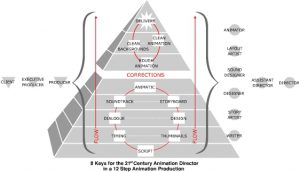The GDD is the “script” for a video game. Ant’s Life is a simulation game.
simulation game (noun) Refers to games that attempt to accurately depict situations and experiences one might have in the real world.
source: factmonster
A simulation video game describes a diverse super-category of video games, generally designed to closely simulate aspects of a real or fictional reality.
A simulation game attempts to copy various activities from real life in the form of a game for various purposes such as training, analysis, or prediction. Usually there are no strictly defined goals in the game, with players instead allowed to freely control a character.[1] Well-known examples are war games, business games, and role play simulation.
source: wikipedia
example of a GDD
http://www.cs.tufts.edu/comp/150CIS/AnAntsLife/AnAntsLife-GameDesignDocument.pdf
GDD template:
https://docs.google.com/document/d/1-I08qX76DgSFyN1ByIGtPuqXh7bVKraHcNIA25tpAzE/edit
How does the language in a GDD differ from the language in a film or commercial script?
–> How is the player taken into account?
Game Structure: Control
The player experiences the world as Annie the ant, through a first-person rendering of the mapping the ant’s senses in the human visual and auditory domain (see Ant-Human Interface). The player can move about freely in the world, where objects are subject to the physical laws and effects that dominate at the ant’s scale. The game is organized in levels that correspond to the different stages/roles in the life of the ant. The player progresses in the game by accumulating experience and points in return for accomplishing simple tasks. Each ant role has its own objectives and tasks. All tasks involve picking-up, transporting and delivering objects from and to specific areas. The player must at all times ensure its immediate well-being as an ant, interact with its sisters, and fulfill the tasks that characterize the roles it comes to take over its life. The world is populated by sister ants and other critter. The player interacts with other agents through its normal ant interaction modality: offering, exchanging or receiving food.
Types of video games:
action (noun)Game genre that requires the player to have quick reflexes.
adventure (noun)Game genre in which the player follows a story, solves puzzles, interacts with non-player characters, and explores the “world”.
advergame (noun)Type of game that has been created solely to promote a product, such as a movie.
anime (noun)A style of animation originating in Japan that is characterized by stark, colorful graphics. Numerous videogames have environments and characters influenced by anime.
arcade game (noun)A stand-alone game for use in a public space, commonly seen in the 1980s and early 1990s.
educational game (noun)A game genre that is intended to teach younger players.
edutainment (noun)A game genre that is intended to entertain as well as be educational.
M.M.O.G. (Massively Multiplayer Online Game) (noun)Refers to online games that can be played simultaneously with other gamers throughout the world. Poptropica is an example of a M.M.O.G.
M.M.O.R.P.G. (Massively Multiplayer Online Role-Playing Game) (noun)Similar to an MMOG, but in which the gamer takes the part of a character. World of Warcraft is an example of a M.M.O.R.P.G.
R.P.G. (Role-Playing Game) (noun)A game in which the gamer takes on the part of a character.
RTS (Real Time Strategy Games) (noun)The player has a high degree of control over armies and individual units, as well as building bases, gathering resources, and developing technology. Age of Empires III is an example of an RTS game.
sandbox (noun)A game in which the player ignores the game’s objectives so as to explore the game’s environment. Sandbox games are also referred to as nonlinear or open-ended. The Grand Theft Auto series allows for open-ended play.
Think about the mood that these types of games have and the mood that the player has to be in to play them…
more terminology: http://www.factmonster.com/science/computers/video-game-glossary.html




